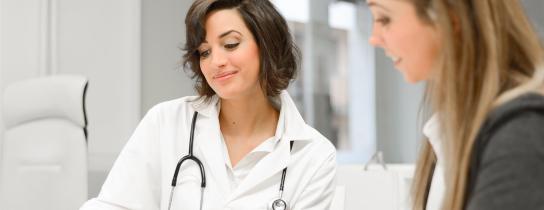
“The Breast Cancer Gene” – What is it and Who is at Risk?
Our genes carry important information for cells about how they should grow and function. However, when genes contain errors or changes, cells receive incorrect information and grow and function abnormally. These errors or changes can occur over one’s lifetime or can be inherited from a parent. When inherited genes cause negative health conditions like cancer, they are known as mutations.
The BRCA1 and BRCA2 genes are known to greatly increase the risk of developing breast cancer in women, but there are several other risk factors associated with the development of the disease. There are also many options to consider in terms of testing, prevention, and treatment of breast cancer for women in New York State.
The Breast Cancer Gene, Explained
The BRCA1 and BRCA2 genes are found in every human body. Responsible for maintaining the normal growth and repair of ovarian, breast, and other cells, these genes can function abnormally when they contain mutations that have been inherited. However, a mutation in the BRCA 1 or 2 gene doesn’t necessarily mean a woman will be diagnosed with breast cancer.
BRCA1 vs. BRCA2
BRCA1 and 2 genes are both related to increased risk of breast cancer. However, they are each located on different chromosomes and are, therefore, responsible for an increased risk of developing other types of cancer.
A mutation in the BRCA1 gene can increase colon, uterine and cervical cancer risk. It is also associated with triple-negative breast cancer development, which is more aggressive and difficult to treat. BRCA2 mutations increase the risk of developing melanoma, bile duct, gallbladder, and stomach cancer, in addition to breast cancer.
Who Is at Risk for Having BRCA1 and 2 Mutations?
Women with one or more of the following risk factors are more likely to have the BRCA1 or BRCA2 mutation that leads to breast cancer:
- Female family members with instances of cancer in both breasts.
- Breast and ovarian cancer in a single individual or occurring on the same side of the family.
- The existence of the BRCA1 or BRCA2 mutation in the family.
- Breast cancer in a male family member.
- Female blood relatives on either side of the family diagnosed with breast cancer before 50 years of age.
- Instances of other cancers in the family, such as thyroid, colon, prostate, pancreatic, or stomach.
If you have any of the above risk factors, your doctor will likely recommend that you be tested for the BRCA gene mutation which causes breast cancer. However, it’s important to remember that this particular gene mutation isn’t the only one linked to the disease, as detailed below. Also, one instance of a gene mutation in the family does not mean that all family members will carry it. According to the Susan G. Komen Foundation, if your mother had a mutation in her BRCA1 gene, you have a 50% chance of having that same mutation.1
Risk of Developing Breast Cancer if You Have Inherited the BRCA1 or 2 Mutation
The National Cancer Institute has identified the potential for breast and ovarian cancer risk due to BRCA1 or BRCA2 inherited gene mutation. They estimate that 72% of women who have inherited the BRCA1 mutation, and 69% of women who have inherited the BRCA2 mutation, will develop the disease by the age of 80.2
BRCA Testing
The breast cancer gene test is a genetic test which reveals if you have inherited the BRCA gene mutation that causes breast cancer. This test has a few possible outcomes, as well as certain risks and benefits. Seeking the advice of a genetic counselor will help you determine whether genetic testing is right for you.
Other Risk Factors
There are other additional factors which substantially increase the risk of developing breast cancer other than having a mutation in the BRCA genes due to the occurrence of cancer in the family.
A Previous Cancer Diagnosis or Exposure to Radiation
Your risk of developing breast cancer will be higher if you were diagnosed in the past with other types of cancer. The same is true if you were exposed to radiation to the chest or breasts due to radiation treatment prior to the age of 30.
Mutations in Other Genes
Research shows that mutations in the chromosomes, along with having the mutations in the BRCA1 or BRCA2 genes, can mean an increased risk for developing breast cancer. There are also other genes besides the BRCA genes which have been associated with breast cancer, but, in these, mutations causing the disease are rare.
Lifestyle
Women who have been informed by a women’s health specialist about abnormalities in the BRCA1 or BRCA2 genes may increase their risk even further if they are not maintaining a healthy weight, not exercising regularly, and not consuming a healthy diet, or limiting their alcohol intake. Risk is also increased if they are a smoker.
Low Vitamin D
Women with low levels of Vitamin D may have a higher risk of developing breast cancer. Although sunlight is the best way to activate Vitamin D production in the skin, increased use of sunscreen or avoiding sun exposure altogether means little or no sunlight-activated Vitamin D production, which can lead to a deficiency.
If it’s not possible to get more direct sunlight where you live or work, you can increase your Vitamin D levels by first testing your serum level, and then treating any levels found to be lower than normal with Vitamin D3 supplements.
Certain healthy foods can also help increase Vitamin D levels. Fish like salmon, mackerel, sardines, herring, and steelhead trout are all high in Vitamin D. When eating fish, be sure to avoid species which tend to be typically high in mercury. Other foods include any yogurts, juices, and milks that have been fortified with Vitamin D. This information will appear on the label.
It’s important to understand that having one or more of the risk factors above, along with others such as high breast density, taking birth control pills, or using combination hormone therapy, does not necessarily mean that you will develop the disease.

Risk-Reducing Strategies
In addition to testing by a women’s health center, there are several options for reducing the risk of developing breast cancer. Some women opt for surgery, while others choose hormonal therapy or frequent screening.
Dual Mastectomy
Prophylactic or bilateral mastectomy, in which both breasts are removed, is a common and very effective prevention method for women identified as having a very high risk of developing breast cancer. Just how effective is breast surgery? According to the Susan G. Komen Foundation, women at high risk of developing breast cancer can reduce their risk by at least 90% with a double mastectomy.3
If you’re considering this avenue of prevention, it’s important to speak with your doctor regarding the benefits and considerations involved.
Removal of Fallopian Tubes and Ovaries
Women who have not yet experienced menopause, but who have been identified as having mutations in their BRCA1 or BRCA2 genes, may experience a 50% reduction in breast cancer development risk by having surgery to remove their ovaries and Fallopian tubes, according to BreastCancer.org.4
Hormone Therapy
There are two hormones which have been identified as being successful in reducing the risk of hormone-receptor-positive breast cancer: two aromatase inhibitors, and two selective estrogen receptor modulators. Some of the hormonal therapy medicines used in these particular cases include:
- Arimidex
- Tamoxifen
- Aromasin
- Evista

Screening
Women who have been identified as being at high risk for developing breast cancer due to inherited BRCA1 or BRCA2 gene mutations can benefit from more frequent screenings. This can be accomplished by developing a screening plan with your doctor that can include the following if you’re 30 years and under:
- MRI scan on a twice-yearly basis.
- A digital mammogram twice per year.
- A yearly breast exam by your doctor.
- Conducting a self-exam of your breasts each month.
The frequency of screening, as well as the time period between certain screenings, may differ according to the organization through which you are receiving them. Another method of screening is to undergo an ultrasound of the breast.
Finding the Right Testing and Treatment
The importance of finding the best team to assist you with testing and treatment for breast cancer cannot be understated. However, with so many options, it can be difficult to identify the best route to take. Community cancer care at Crystal Run Healthcare includes consultation with breast cancer specialists and primary health care practitioners to identify the best options for you. Call 1-845-703-6999 to learn more about your treatment options in Middletown, Monroe, Newburgh, Rock Hill or West Nyack, NY.
Sources:

 Optum Radiology at Crystal Run Healthcare
Optum Radiology at Crystal Run Healthcare Request medical records online
Request medical records online